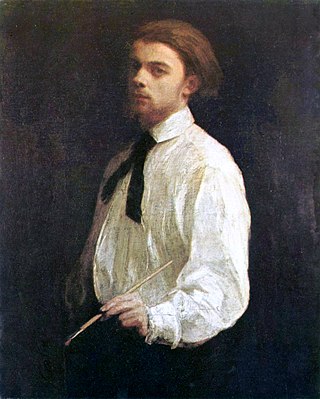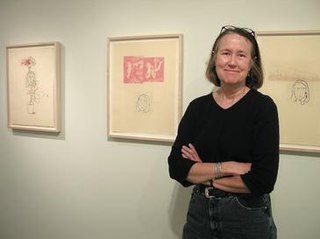
Henri Fantin-Latour was a French painter and lithographer best known for his flower paintings and group portraits of Parisian artists and writers.

Monotyping is a type of printmaking made by drawing or painting on a smooth, non-absorbent surface. The surface, or matrix, was historically a copper etching plate, but in contemporary work it can vary from zinc or glass to acrylic glass. The image is then transferred onto a paper by pressing the two together, using a printing-press, brayer, baren or by techniques such as rubbing with the back of a wooden spoon or the fingers which allow pressure to be controlled selectively. Monotypes can also be created by inking an entire surface and then, using brushes or rags, removing ink to create a subtractive image, e.g. creating lights from a field of opaque colour. The inks used may be oil or water-based. With oil-based inks, the paper may be dry, in which case the image has more contrast, or the paper may be damp, in which case the image has a 10 percent greater range of tones.

USS Virginia (SSN-774) is a nuclear powered cruise missile attack submarine and the lead ship of her class, currently serving in the United States Navy (USN). She is the tenth vessel of the Navy to be named for the Commonwealth of Virginia, as well as the second US Navy attack submarine to be named after a state, a pattern that is common throughout her class.

Rembrandt Harmenszoon van Rijn, usually simply known as Rembrandt, was a Dutch Golden Age painter, printmaker, and draughtsman. An innovative and prolific master in three media, he is generally considered one of the greatest visual artists in the history of art. It is estimated Rembrandt produced a total of about three hundred paintings, three hundred etchings, and two thousand drawings.
Gordon Frickers is a marine artist based in Plymouth, Devon, but also paints in France. Frickers was the first marine artist to be exhibited at the European Parliament in Brussels in May 2011.

Robert Salmon was a maritime artist, active in both England and America. Salmon completed nearly 1,000 paintings, all save one of maritime scenes or seascapes. He is widely considered the Father of American Luminism.
Edgar Soberon is a Cuban-born American painter and printmaker.
Dorothy Stratton King was an American painter and printmaker. She was a founding member of the Washington Printmakers Gallery in Washington, DC. Her work is held by several public collections in the USA.

Jan Abrahamsz Beerstraaten or Johannes was a Dutch painter of marine art, particularly of events of the First Anglo-Dutch War and Dutch-Swedish War. Van Beerstraten depicted ports (Civitavecchia) and cityscapes of Amsterdam, as well as many cities and villages in the Netherlands. He captured castles, churches and other buildings that no longer exist.

The Hundred Guilder Print is an etching by Rembrandt. The etching's popular name derives from the large sum of money supposedly once paid for an example. It is also called Christ healing the sick, Christ with the Sick around Him, Receiving Little Children, or Christ preaching, since the print depicts multiple events from Matthew 19 in the New Testament, including Christ healing the sick, debating with scholars and calling on children to come to him. The rich young man mentioned in the chapter is leaving through the gateway on the right.
Dr James Taylor MA (Hons), FRSA is a British author, expert on maritime art, and former curator of the National Maritime Museum, Greenwich, east London.

The visual arts are art forms such as painting, drawing, printmaking, sculpture, ceramics, photography, video, filmmaking, comics, design, crafts, and architecture. Many artistic disciplines, such as performing arts, conceptual art, and textile arts, also involve aspects of the visual arts as well as arts of other types. Also included within the visual arts are the applied arts, such as industrial design, graphic design, fashion design, interior design, and decorative art.
John Silk Deckard was an American artist from Erie, Pennsylvania. He worked in a number of media, including drawing, painting, printmaking, and sculpture.

Heesen Yachts is a Dutch ship building company that specialises in custom built superyachts. Founded in 1978, it has launched more than 170 yachts since its inception, many of which have won awards. It is considered one of the world leaders in the design, construction and engineering of all-aluminum yachts.
Andrew Stein Raftery is an American artist and educator, known for his paintings, burin engravings, and drawings on fictional and autobiographical narratives of contemporary American life.

Bernard Childs (1910–1985) was an artist who worked in Paris and New York. He was primarily a painter and printmaker, and pioneered the direct engraving of metal plates with power tools. As a kind of counterpoint to his many-layered work, which is often symbolic and a fusion of abstraction and figuration, in 1959 he also started painting portraits. Childs' formal interests were line and space, light and color, and the dialogue of contrasting elements.
Thomas H. Willis was a Danish-born American artist who combined marine art, folk art, and needlework in his portraits of American and European sailing ships, steamers, pilot boats and yachts. His works are represented in maritime museums including the Mystic Seaport Maritime Museum, The Peabody Museum of Salem in Massachusetts and The Mariners' Museum and Park in Newport News, Virginia. He died in New York City in 1925.

Barbara Tisserat (1951–2017) was an American artist and lithographer born in Denver, Colorado. She taught lithography at Virginia Commonwealth University's School of the Arts. She was a member of One/Off Printmakers and also taught at the Virginia Museum of Fine Arts Robinson House lithography workshop with Marilyn Bevilacqua. She was active with the Richmond Printmaking Workshop and served on the Advisory Board of Studio Two-Three in Richmond, Virginia. She was a member of the Summer 2007 graphics faculty at Haystack Mountain School of Crafts and was a visiting artist and lecturer in the Lyceum program at Emory and Henry College.

Hyman J. Warsager (1909–1974) was an American artist known for his printmaking.

Tom Hammick is painter and a printmaker working in London. He was Glyndebourne's Associate Artist during the 2021 and 2022 festivals.





















